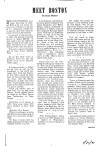
Home Page Meet Boston Menu Index
|
MEET BOSTON Friday, January 31, 1941 in What's New In Town W. J. Sidis |
Benjamin Franklin, as a great advocate of thrift, left $100 in his will to his native town of Boston, to be put at 6% compound interest for a century, and then used for some work of public benefit.
At the end of that period―in 1890―the original sum had grown to nearly $40,000. It was used to buy an extensive piece of land to be used as a park. The place is now called Franklin Park, after the donor.
This park is nearly the same size as New York’s Central Park.
Of all the large cities in America, Boston has the purest and most plentiful water supply.
*
If it were possible to flatten out all hills as well as the roundness of the earth between New York and Boston, so that there would be clear view all the way between the two cities, then the Boston metropolis, as seen from New York, would appear about as large as the State House from the public garden.
While the settled part of New York City, as seen from Boston, would appear about as large as the State House from Technology in Cambridge.
*
According to the census of 1930, there were about 2700 cows resident in New York City.
And only 90 in Boston.
Which would seem to prove that Boston is nowhere near as much of a cow-town as New York.
Or does it mean that the larger population of New York consists mainly of cows?
*
In the Eighties and Nineties, the hotel district of Boston was along Kneeland and Beach Streets, readily accessible to the Boston & Albany and the New England Railroad Depot which were then on Kneeland Street, as well as to the old Providence Depot in Park Square, which occupied the present site of the Hotel Statler. Some of the old hotel buildings are still standing, being now used as offices and lofts of establishments in the neighborhood of Boston’s Chinatown. One collapsed under a “Charleston” dance party in 1924. One is now a department store.
*
Movie fans may be interested in looking up 9 Harcourt St. Now just a loft building, it is the place where Technicolor was invented about a quarter century ago. The inventors were physics instructors at the Massachusetts Institute of Technology, and named their invention for Technology. Shortly after the Armistice, they moved into larger quarters, at 110 Brookline St. (now occupied by the Hemphill Diesel School), which remained Technicolor headquarters for some fifteen years, manufacturing Technicolor film in Boston and sending out its own special directors from here.*
*
Harcourt Street is just another one of Boston’s blind alleys, leading off St. Botolph Street in the Back Bay. But, in Boston, even blind alleys are productive of important things.
*
That “Emancipation” statue of Lincoln in Park Square has a replica in Washington standing in Lincoln Square of that city.
The model who posed for the part of the kneeling slave for that statue was an ex-slave from Missouri, one of the first to be freed by the orders of General Fremont when he operated in that State in 1861.
*
That car track in Park Square that loops around the Lincoln statue, used to be the terminal of the old Boston & Worcester “trolley air line,” which gave rapid service between here and Worcester, such as the buses have been unable to give since the trolleys were taken off that line.
*
In the days preparatory to the American Revolution, the symbol of liberty was the Pine Tree, which had before that been a sacred emblem of the Penacook peoples that inhabited a large part of New England, and whose symbol stood for New England’s traditions of freedom.
Towns in Massachusetts (including Maine, which then belonged to Massachusetts) planted “liberty trees” in symbol of the revolt ahead. Boston planted one on the bay shore of the Common (now the Public Garden) but, while the Pine Tree was growing up, they used an elm that was standing at Washington and Essex, on the present site of the RKO Boston Theatre. It was there that demands were presented in 1773 to the captain of the Dartmouth not to unload his famous load of Amoy tea.
Across Essex Street stands a building on whose Washington Street front is a stone panel bearing a likeness of this original Liberty Tree.
________
* The inventor of Technicolor was Herbert T. Kalmus, a fellow researcher with Boris Sidis. W. J. may have known Kalmus, or at least have met him. See Boris Sidis Bibliography. See also letter from Kalmus to Sarah Sidis which speaks very highly of Boris.